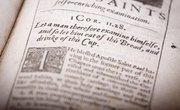Poetry often means much more than what appears on the surface, so reading carefully and figuring out the poet’s intended message is the key to analyzing poetry in the middle grades. According to Common Core State Standards for Literature, poetry analysis in a middle-grades text should focus on using the form and structure of a poem as well as the author's use of figurative language, to understand its meaning. To do this, you'll need to read through the poem several times.
Gain a General Understanding
Look at the poem's title for clues about its content before reading carefully through the entire poem once. Try to gain a general impression: Who is speaking? What story does the poem seem to be telling, or what situation is being described? Robert Frost's "Nothing Gold Can Stay," for example, seems to describe the inevitable change of seasons in nature. For less-familiar subjects, it may be helpful to find out a little about the author and the historical context of the poem. If you discover that the poem was written during a war, for example, watch for combat images or any thoughts that the poet reveals about war. Once you feel that you have a good general understanding of the poem's surface-level content, move on to your second reading.
Identify Form and Structure
On your second reading, look at how the poem is formatted. Does the poem appear to follow a familiar form, such as sonnet or haiku, or does it appear to be written as a letter or song? Read the poem aloud to get a feel for the beat or rhythm of the words and any rhyming patterns, such as the pairs of rhyming lines -- called couplets -- in "Nothing God Can Stay." These sound devices may give the poem a light, carefree mood, or they may add to its tension. Look also at how the lines are arranged. They may be grouped into paragraph-like stanzas, each with a new main idea that contributes to the overall meaning, or lines may stand alone for impact. Poetry can be visual, so the "Core Analysis Frame" for middle school poetry suggests looking at the white spaces on the page for any images they may bring to mind.
Examine Word Choice
Once you've evaluated the structure of the poem, read through a third time with an eye out for the specific words and phrases that the poet includes. Since a poem’s meaning is often below the surface, look for examples of symbolism that the poet may have used to represent a bigger idea, such as Frost's use of "green" as a symbol of youth and turning leaves to represent the passage of time. Look also for similes, metaphors or literary allusions, as these comparisons may bring to mind the deeper ideas that the poet hopes to convey. A reference to a well-known biblical story like the fall of Eden, as Frost uses, may evoke moral lessons that readers will be familiar with -- in this case, the corruption of innocence. Lastly, watch for any words or phrases that are repeated to add emphasis to the author’s point, and don’t ignore the final line -- it often wraps up the poet’s overall view of the topic.
Determine the Overall Message
Once you have read through the poem several times and looked at each line for hidden meaning, you should be ready to make a statement about the poem’s theme, or the overall message that the poet meant to express. Frost, for example, uses his symbolic poem to make a statement about how time corrupts the innocence of youth. This may or may not be the impression that you had after your first basic reading. Try to put this overall idea into one sentence, such as "Youthful innocence cannot last forever" and be prepared to defend it with the specific ideas from the text. Using the structure and language of the poem to determine this overall meaning is the goal of poetry analysis in the middle grades.
Related Articles
References
Writer Bio
Bethany Richardson has been an educator in Texas public schools since 2007. She has a Bachelor of Arts in English rhetoric with a professional writing certificate from Texas A&M University in College Station, Texas.











